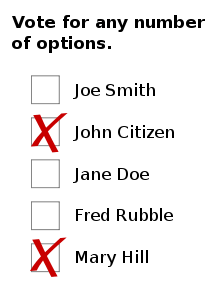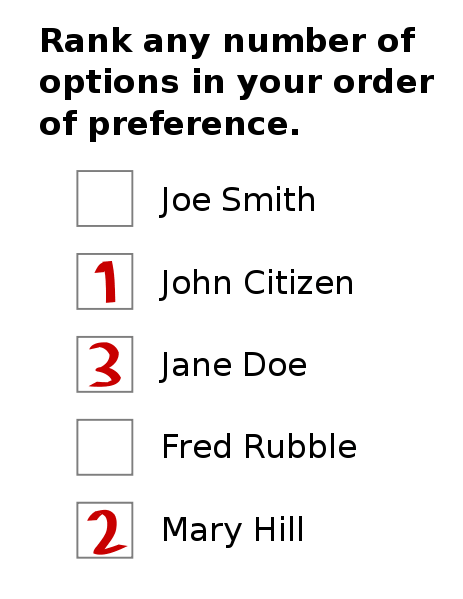Michael Ossipoff’s Election Methods Properties Series
Main Categories of Properties and Criteria.
2. List of Pass/Fail Criteria That Will Be Used (Without Definitions)
3. Cast of Characters
List of the Methods Being Compared (Without Definitions).
4. Methods, With Definitions, Properties, Criterion-Compliances, and Some Notable Criterion-Failures. Definitions of Criteria and Properties When Needed
The Section on Each Method Will Conclude With a Compact List of the Names of its Compliances and Desirable Properties.
In topic 4, properties, including criterion-compliances, will be discussed in order of importance starting with the criteria most relevant to strategy. Beginning with a general description of the method’s strategy, I will then discuss other important properties, such as count-fraud vulnerability and enactability, ending with some of the less important criteria.
5. (As Cross-Referencing) Properties and Criteria, With Complying and Failing Methods
Definitions of Any Discussed Properties Not Previously Defined.
6. Conclusions
Where We Are in Voting System Reform. The End of the Proposal-Selection Period is Overdue. Time for the Outreach and Enactment Period.
It is better to debate a question without settling it than to settle it without debate.
It’s important to address arguments from people who claim that other voting systems are better, or that other criteria are more important. That’s why I invited traditional unimproved Condorcet (TUC) advocates on the election-methods mailing-list to give their opinion as to what mitigating advantages TUC has, to outweigh the disadvantages that I described. One reason why voting-system discussion doesn’t get anywhere is because people are only trying to justify their pre-existing positions. Speaking for myself, I don’t want to be like that. That isn’t genuine discussion. Therefore I both sent my invitation at election-methods and I wrote this article.
I’ve gotten a few answers at the mailing-list, and I feel that I should answer them in an article. This article interrupts the scheduled procedure of this Properties article series, but it can be considered part of the series because it’s about arguments regarding properties and their importance. I feel that this article supports the claims that I make in the other articles of this series. It’s important that I be willing to support my claims, and address objections.
After this article I will resume the evaluation particular methods by properties and criteria. Subsequent articles in this series will deal with the properties of the Majority-Judgment voting system—a table that summarizes the properties and criterion-compliances of the methods that I’ve been comparing—and an article about where we are in voting system reform, and what can be done at this time.
Traditional unimproved Condorcet (TUC) is popular these days. Its most popular version is a method called Beatpath. As I’ve said, the TUC methods fail FBC and CD, and don’t meet any form of LNHe. That results in drastic strategy-need that Approval, Score, ICT, and Symmetrical ICT don’t have. In particular, failure of FBC makes TUC a strategic mess.
TUC advocates claim that people will rank sincerely in TUC. But American voters firmly hold certain beliefs about candidate win-ability. They get their beliefs from the mass media, and seem to believe whatever they hear from their TV. Voters here nearly all believe that no one can win except for the Democrat and the Republican. They firmly believe that the winner must be a Democrat or a Republican. Furthermore, people who want something better than the Republican, including all progressives, including the millions of people who’d prefer something better than the Democrat too—those people regard the Republican as entirely unacceptable. They think that that the Democrat is acceptable (largely because of what their TV says), and feel that it’s all-important that the Democrat win instead of the Republican. They’ve amply expressed and demonstrated their willingness to bury their favorite, in order to help the Democrat beat the Republican.
It’s easily shown that, in TUC, given the beliefs described in the previous paragraph, the optimal strategy would be to rank the Democrat alone in first place. And, according to those beliefs, if the Democrat isn’t one’s favorite, then one should rank one’s favorite below the Democrat. I, myself, would favorite-bury in a TUC election, if there were only one acceptable candidate who could win, and s/he weren’t my favorite. (But that wouldn’t be a Democrat. I don’t regard Democrats as acceptable—I consider the Greens acceptable). The belief on the part of TUC advocates that people would rank sincerely in TUC elections is unwarranted wishful thinking.
Anyway, as I was saying, I asked TUC advocates at the election-methods mailing list what mitigating advantages they think that TUC has. Eventually I got a few answers. Someone cited Clone-Independence and Reverse-Symmetry. My previous article gave a complete answer regarding Reverse-Symmetry. I’d like to say a little more about Clone-Independence. Relevant to the methods that I recommend, Clone-Independence says (something to the effect that) when some new candidates are added, who are nearly identical to the winning candidate (in the clone sense described in the previous article), then, if people vote sincerely, the winner should either be the previous winner, or one of his/her new clones.
Adding those clones doesn’t cause a problem in the methods that I propose. If it’s a u/a election (defined in previous articles), as I claim all of our official public elections are, then, in Approval, one should approve all of the acceptables, but none of the unacceptables. In ICT, one should top-rank (only) all of the acceptables. The addition of clones causes no dilemma or question about how to vote. The same simple rule continues to apply. But, in any case, in any kind of an election, in spite of clones, there won’t be a split vote problem if people approve or top-rank all the best candidates, all of the good ones that they might need. The objector at election-methods didn’t like that strategy-need, but remember that these are clones, and therefore probably of very similar merit. So how bad can it really be to have strategic reason to approve or top-rank them together? Instead of naming the objector at election-methods, I’ll just call him “Objector”.
Sure, the clone-independent properties of such methods as Beatpath have some value, and, for fairness, one should look at what would have to be traded in order to get such properties as Clone-Independence, MMC, etc. Then, it would desirable to compare, without prejudice, the desirability of what would be lost in the trade to what would be gained in the trade. In fairness, it could be worth considering whether it would be worthwhile, for example, to trade CD for Clone-Independence. Would it be a good trade?
Objector’s arguments should be considered. He doesn’t like the Approval-like strategy that a non-clone-independent method can have in a clone situation. He says that if, in ICT, there’s strategic need to top-rank all of the clones, that looks to him like Approval strategy, which he doesn’t like.
What Objector is saying is that, when ICT doesn’t improve on Approval, it has Approval strategy. If so, then ICT can be called an improvement on Approval. That’s more than can be said for TUC, given its drastic, largely unknown, guesswork strategy needs: Its miserable strategic mess. Improving on Approval is easier said than done. Objector would like to get rid of Approval’s strategy need. The problem is that, when we do that, we tend to get worse strategy needs. TUC advocates are in denial about that.
If CD can be gained, without making anything worse than Approval, then we have a net gain. ICT and Symmetrical ICT achieve that. Admittedly, ordinary ICT shares TUC’s bottom-end strategy need, but CD compliance is worth that loss, because the chicken dilemma can prevent a voter from ranking his/her second choice—and that matters more than bottom-end strategy. But Symmetrical ICT gets rid of bottom-end strategy need.
TUC does make things considerably worse than Approval, with its top-end strategic mess. It could be argued that, in my chicken dilemma examples (given in previous articles) if A and C are cloned, and the A voters and C voters split their vote among the clones, then, ICT won’t benefit from its CD compliance, because the B voters can successfully defect. Yes, but they’d still have to know that B has the most top-votes (regardless of whether that’s because of clones and split vote among the A voters and the C voters).
Likewise, for successful burial strategy, the B voters would need to know that too. So I suggest that ICT has uniquely powerful deterrence against defection and burial. If we compare ICT to Beatpath, the difference is between, at worst, Approval strategy, versus the more drastic strategy-need of Beatpath. But what about trading CD for Clone-Independence?
I suggest that the chicken dilemma is worse than ordinary Approval strategy. That suggests that trading CD for Clone-Independence would be a poor trade. So far, I haven’t been limiting the discussion to u/a elections. When we specifically discuss u/a elections, the conclusions become even more obvious and clear-cut: I suggest that our official public elections, at least for state and national office, are always u/a elections. Let me repeat the u/a strategy of the methods we’re discussing:
Approval:
Approve all of the acceptables, and none of the unacceptables.
Score:
Top-rate all of the acceptables. Bottom-rate all of the unacceptables.
ICT:
Top-rank the acceptables and none of the unacceptables. Rank the unacceptables below top, in reverse order of win-ability.
Beatpath:
Beatpath at bottom-end:
Rank the unacceptables below the acceptables, in reverse order of win-ability.
Beatpath at top-end:
Unknown. Maybe try to top-rank the acceptables most likely to win, and rank the other unacceptables below top, maybe in order of win-ability. That’ only a guess.
Symmetrical ICT:
First, you should top-rank the acceptables. Then, you should bottom-rank the unacceptables just like Approval strategy. Approval strategy is the best that you can get, except for gaining CD compliance).
Since the best you can get, in u/a elections, is Approval strategy anyway, the Approval strategy that non-clone-independent methods can have in clone situations isn’t a loss. Rather than evade objections, criticisms, and opposing arguments, this article’s purpose was to answer some arguments about Clone-Independence, and, in general, about the merit comparison of Approval, Score, ICT, and Symmetrical ICT, vs. TUC.




Michael Ossipoff says
Thanks for the good words. I know you were speaking of the Democracy Chronicles website in general, but I take it as a compliment that your comments were posted at my article.
Yes, discussion and debate of alternative voting systems has become bogged-down in some traditional Condorcet methods.
The subject of voting systems has been long-overdue for questioning and updating.
Thanks for your favorable comments.
Markus Schulze says
Dear Mike Ossipoff, I am very sorry to have to disappoint you. But the message by “ugg boots for cheap” has been posted to thousands of websites. Obviously, the message has been posted by a bot.
Michael Ossipoff says
Markus:
Some posts are from bots. That’s common knowledge.
You didn’t disappoint me. Don’t be so hard on yourself, Markus.
But I’d rather reply to a post from a bot, than not reply to one that’s legitimate.
Therefore, I assume that posts are legitimate.
People post with all sorts of names. I don’t claim to know, from a post’s name, that the post is from a bot.
Businesses sometimes have e-mail accounts that are named after the business. Sincere and legitimate posts can be sent via such an e-mail account. There’s no need to assume that a post is from a bot, if the account is named for a business.
I don’t know what motive or purpose would lead someone to send bot-posts to websites, but, then, neither do I care.
You, Markus, seem more interested in bots than I am.
Michael Ossipoff
Markus Schulze says
Dear Mike Ossipoff, you wrote: “I don’t know what motive or purpose would lead someone to send bot-posts to websites.” The purpose is to create a link to an online shopping website.
Michael Ossipoff says
I didn’t notice the link. I only noticed the commercial account-name, which, by itself, didn’t prove anything. Maybe there was a link, but I didn’t notice it.